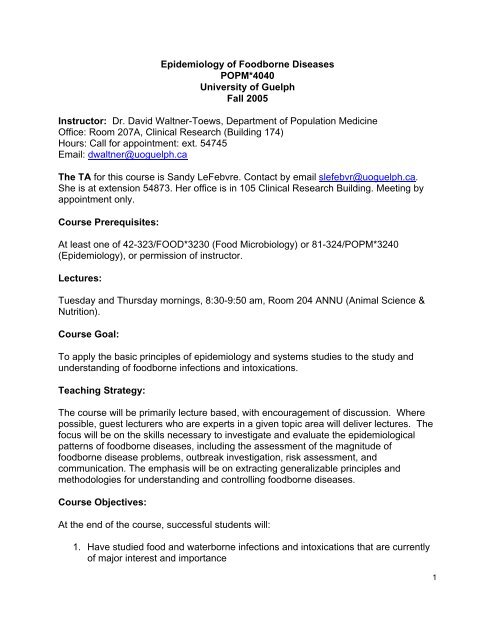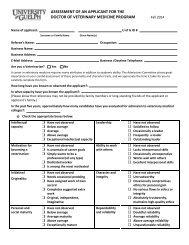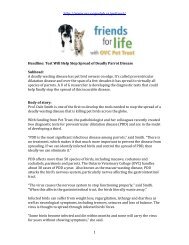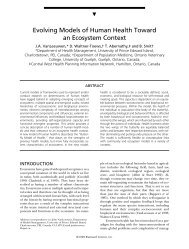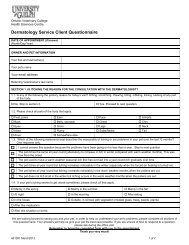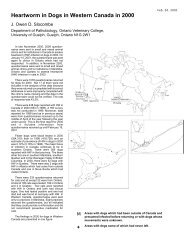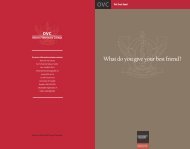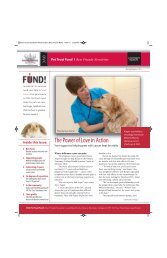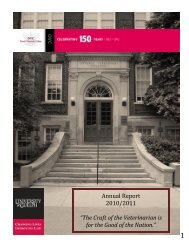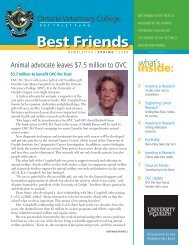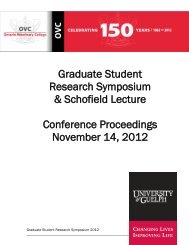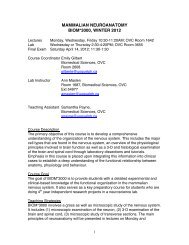POPM*4040 - Ontario Veterinary College - University of Guelph
POPM*4040 - Ontario Veterinary College - University of Guelph
POPM*4040 - Ontario Veterinary College - University of Guelph
Create successful ePaper yourself
Turn your PDF publications into a flip-book with our unique Google optimized e-Paper software.
Epidemiology <strong>of</strong> Foodborne Diseases<br />
<strong>POPM*4040</strong><br />
<strong>University</strong> <strong>of</strong> <strong>Guelph</strong><br />
Fall 2005<br />
Instructor: Dr. David Waltner-Toews, Department <strong>of</strong> Population Medicine<br />
Office: Room 207A, Clinical Research (Building 174)<br />
Hours: Call for appointment: ext. 54745<br />
Email: dwaltner@uoguelph.ca<br />
The TA for this course is Sandy LeFebvre. Contact by email slefebvr@uoguelph.ca.<br />
She is at extension 54873. Her <strong>of</strong>fice is in 105 Clinical Research Building. Meeting by<br />
appointment only.<br />
Course Prerequisites:<br />
At least one <strong>of</strong> 42-323/FOOD*3230 (Food Microbiology) or 81-324/POPM*3240<br />
(Epidemiology), or permission <strong>of</strong> instructor.<br />
Lectures:<br />
Tuesday and Thursday mornings, 8:30-9:50 am, Room 204 ANNU (Animal Science &<br />
Nutrition).<br />
Course Goal:<br />
To apply the basic principles <strong>of</strong> epidemiology and systems studies to the study and<br />
understanding <strong>of</strong> foodborne infections and intoxications.<br />
Teaching Strategy:<br />
The course will be primarily lecture based, with encouragement <strong>of</strong> discussion. Where<br />
possible, guest lecturers who are experts in a given topic area will deliver lectures. The<br />
focus will be on the skills necessary to investigate and evaluate the epidemiological<br />
patterns <strong>of</strong> foodborne diseases, including the assessment <strong>of</strong> the magnitude <strong>of</strong><br />
foodborne disease problems, outbreak investigation, risk assessment, and<br />
communication. The emphasis will be on extracting generalizable principles and<br />
methodologies for understanding and controlling foodborne diseases.<br />
Course Objectives:<br />
At the end <strong>of</strong> the course, successful students will:<br />
1. Have studied food and waterborne infections and intoxications that are currently<br />
<strong>of</strong> major interest and importance<br />
1
2. Have applied epidemiological concepts to the study <strong>of</strong> the etiology, impact and<br />
control <strong>of</strong> food-and-waterborne diseases, including their ecological and socioeconomic<br />
contexts<br />
3. Be able to integrate science with socio-political understanding to make informed<br />
arguments about the management <strong>of</strong> risks and uncertainty related to food-andwaterborne<br />
diseases<br />
4. Have learned how to communicate the nature <strong>of</strong> risks associated with food-andwaterborne<br />
diseases to both the general public and specific vulnerable<br />
populations.<br />
Marks:<br />
Food Diary and Reflection 15%<br />
Book Review 15<br />
Take-home midterm/Outbreak Investigation 20<br />
Public Dissemination 20<br />
Town Hall Meetings 10<br />
Final Exam 20<br />
Comments on Assignments/Exams:<br />
For the diary and reflection, you will be asked to keep a detailed record <strong>of</strong> what you<br />
ate everyday for one week (7 days), starting on Monday Sept 19, 2005. The diary is<br />
worth 5 marks. For each meal write down:<br />
• What you ate (food types)<br />
• Where it came from (country/region). Note: This does not mean “Zehrs”! This<br />
may require reading labels, reading price cards on fruits/veggies, asking the store<br />
owners about meat or vegetables, calling manufacturers, etc. if foods are not<br />
labeled as to origin,<br />
• Method <strong>of</strong> preparation (e.g. boiled potatoes, baked ham, toasted bread, etc.)<br />
You will then reflect briefly on the foodborne disease implications <strong>of</strong> that diet, using the<br />
ideas and techniques presented in class. Warning: this will require some critical<br />
thought!! For instance, think about:<br />
1. Where your food came from (<strong>Ontario</strong>? India? Mexico?) – what are the<br />
implications <strong>of</strong> this?? As one example, consider that this will have an impact on<br />
how your food was handled en route to you, and therefore the risk posed…<br />
2
2. The type <strong>of</strong> food you ate (chicken? tomatoes? sprouts? cheese?), and how you<br />
prepared it (raw chicken? fried tomatoes? raw sprouts? What about your cooking<br />
techniques, hygiene, how the food has been handled since in your possession,<br />
etc. etc.) – what risks are inherent in your diet as a result <strong>of</strong> your food choices<br />
and preparation methods?<br />
Write this as if you were writing an editorial for the Canadian Journal <strong>of</strong> Public Health,<br />
complete with a few references, on the topic: The Foodborne Disease Implications <strong>of</strong><br />
My Daily Diet. According to the managing editor there, they have no strict rules for<br />
editorials, just 1200-3000 words, and they leave it up to the writer how they want to<br />
focus their editorial. Basically, it should provide a comment/the author’s opinion on a<br />
given topic, to spark interest/raise awareness in the readership/raise the pr<strong>of</strong>ile <strong>of</strong> given<br />
topic (have a look at some CJPH back issues for examples). Note: attention should be<br />
paid to format, grammar and writing style. The reflection is worth 10 marks. Due in<br />
class, with diary, on October 11, 2005.<br />
The book review is a review <strong>of</strong> Fast Food Nation, written in the style <strong>of</strong> the Canadian<br />
Journal <strong>of</strong> Public Health. (See the journal’s Guidelines for Authors and look at the<br />
paper journal in the library for examples). The review should give clear evidence that<br />
you have read the book and thought critically about its content in relation to social,<br />
ecological and food safety issues. See the attached letter on page 8 written by Patricia<br />
Huston, the scientific editor at CJPH for the content requirements <strong>of</strong> your book review!<br />
Due in class October 20, 2005.<br />
The midterm exam is a take-home exam and consists <strong>of</strong> an outbreak investigation.<br />
You will be given a set <strong>of</strong> data on Oct. 20 th , showing who ate what, who got sick, etc.,<br />
and be expected to answer a set <strong>of</strong> questions based on your analyses. As this is the<br />
midterm examination, this is to be done as individuals without consulting others. Due in<br />
class October 27, 2005.<br />
For the public dissemination, you will be asked to select a target group (e.g. an<br />
industry, patients in a doctor’s <strong>of</strong>fice, TV Gourmet chefs, check-out clerks in a grocery<br />
store), a message you think that group needs to be made aware <strong>of</strong>, and design an<br />
appropriate communication to get the message across (brochure, poster, workshop,<br />
web-page, video, song, etc.). If your method <strong>of</strong> communication involves a workshop,<br />
talk, seminar, video, etc., we can give you the opportunity to present it to the class.<br />
You MAY do this in groups, if the project is more complex than a simple poster or<br />
brochure and is approved by the instructor ahead <strong>of</strong> time. Note that everyone in the<br />
group gets the same mark.<br />
The marks for the dissemination are divided into:<br />
• Justification: In 2-3 pages, with references, clearly identify WHO your target group<br />
is, WHAT message you want to get across to them, WHY they need to hear this<br />
message (ideally use a few references to back this up), and WHY you chose the<br />
3
particular form <strong>of</strong> communication that you did. Be sure the form <strong>of</strong> communication<br />
and the language you use is appropriate to your particular target group! (the<br />
average layperson probably doesn't know what a "zoonosis" or "enterocyte" is, for<br />
example) (8 marks)<br />
• Accurate Content (4 marks)<br />
• Message Clarity (language, focus, etc., 4 marks)<br />
• Creativity <strong>of</strong> Project (type <strong>of</strong> communication, layout, design, etc., 4 marks)<br />
General information on risk communication can be obtained from Pr<strong>of</strong>. Doug Powell in<br />
Plant Agriculture (dpowell@uoguelph.ca). Let me know if you need video machines as<br />
those can be checked out from Classroom Technical Services. Computing Services<br />
sometimes <strong>of</strong>fers courses on designing web pages or PowerPoint presentations. Due<br />
November 15, 2005.<br />
Town Hall Meetings: There will be two <strong>of</strong> these. The class will be divided up (by me)<br />
into representatives from industry, farmers/workers, consumer/advocacy groups, media,<br />
the government and local city residents. You will be given a controversial topic and<br />
asked to defend a particular point <strong>of</strong> view, using the best science available at a<br />
simulated public meeting. This is a role playing game. You are encouraged to make<br />
this as realistic as possible – consider your vocabulary, appearance/dress, reactions to<br />
things being said in the meeting, etc. What are the special concerns <strong>of</strong> your group?<br />
Which issues are you concerned about and why? Maybe you don’t have any concerns.<br />
Or maybe you have a lot. Make sure you consider both the science, and the economic<br />
and social consequences to your advocacy group.<br />
Note: these are the only classes where attendance is required! That is, we don’t want<br />
one group skipping out because it’s not their turn (we need a lively audience asking<br />
tough questions).<br />
Therefore, for your participation marks, you are required to hand in a brief comment on<br />
your position (i.e. one or two sentences) at the beginning <strong>of</strong> class. Similarly, at the end<br />
<strong>of</strong> class, you will be required to submit a brief exit statement as to how your position<br />
may or may not have changed as a result <strong>of</strong> the discussion. Therefore, 3 marks (out <strong>of</strong><br />
10) are simply for attending and providing your statements. The remaining 7 marks are<br />
for the presentation <strong>of</strong> your arguments. Done in class on November 24 and 29, 2005.<br />
Final Exam: A short answer exam, covering the whole course, but only asking about<br />
the important things that everyone should know walking out <strong>of</strong> the course (so you don’t<br />
sound like a dope at a cocktail party <strong>of</strong> food safety types). Currently exam date?<br />
4
<strong>POPM*4040</strong> Epidemiology <strong>of</strong> Foodborne Diseases<br />
Note: All lectures will be posted at: http://www.ovc.uoguelph.ca/popmed/ecosys/courses.html. You may<br />
download the powerpoint slides ahead <strong>of</strong> time & write on them.<br />
Class Schedule 2005 (may be subject to change)<br />
Lecture Date Lecturer Lectures and Due Dates<br />
#<br />
1 Sept. 13 DWT Defining the problem: how do people get sick?<br />
2 Sept. 15 Shannon Majowicz Surveillance for Foodborne Diseases: how big <strong>of</strong> a problem is<br />
it?<br />
Sept. 19 N/A Begin food diary<br />
3 Sept. 20 DWT Basic Epidemiology for Foodborne Diseases / Outbreak<br />
Investigations<br />
4 Sept. 22 Andrea Ellis Outbreak Investigation<br />
5 Sept. 27 DWT Salmonella and Campylobacter<br />
6 Sept. 29 David Pearl The E.coli’s: a general introduction and VTEC<br />
7 Oct. 4 Andrew Peregrine Some Foodborne Parasites<br />
8 Oct. 6 DWT Intoxicating Outbreaks: Staph aureus, C. perfringens, B.<br />
cereus<br />
9 Oct. 11 DWT Botulism<br />
DIARY AND REFLECTION DUE<br />
10 Oct. 13 DWT Seafood Toxins<br />
11 Oct. 18 DWT Viruses (Norwalk, Hepatitis)<br />
12 Oct. 20 DWT Shigella, Yersinia<br />
BOOK REVIEW DUE, and Midterm exam (Outbreak<br />
assignment) handed-out<br />
13 Oct. 25 DWT Mycotoxins<br />
14 Oct. 27 DWT Chemicals in Food – an introduction<br />
Midterm (OUTBREAK ASSIGNMENT) DUE<br />
15 Nov. 1 Sandra LeFebvre Risk Analysis/ Assessment: an introduction<br />
16 Nov. 3 Brent Avery Antimicrobial resistance in Food<br />
17 Nov. 8 Wayne Martin BSE and other TSEs<br />
18 Nov. 10 Katarina Pintar Waterborne Diseases<br />
19 Nov. 15 ECCHO Grp? Climate Change and Foodborne Diseases<br />
PUBLIC DISSEMINATION DUE<br />
20 Nov. 17 DWT Town Hall Meeting<br />
21 Nov. 22 DWT Short Answer Quiz<br />
22 Nov. 24 Town Hall Meeting<br />
23 Nov. 29 Montezuma’s Revenge<br />
24 Dec. 1 Ecosystem Health: the Global View<br />
5
Strongly Recommended Texts: (These will be put on reserve at the OVC desk):<br />
Fast Food Nation, Eric Schlosser. Boston: Houghton Mifflin, 2001 (Call #: TX945.3<br />
S355). Since everyone has to write a book review <strong>of</strong> this, and it’s the focus <strong>of</strong> the town<br />
hall meetings, you should probably buy it. It’s a good read in any case and good<br />
background for your editorial based on your diary. Available at the campus bookstore,<br />
the Bookshelf, and Chapters.<br />
Food, Sex, and Salmonella: The risks <strong>of</strong> environmental intimacy. D. Waltner-Toews,<br />
Toronto: NC Press, 1992 (GF 75.W34). Available at the campus bookstore.<br />
Recommended Texts (also on reserve at OVC Reserve Desk):<br />
Procedures to Investigate Foodborne Illness, 5 th edition, published by The International<br />
Association for Food Protection, 1999. An excellent booklet if you are making a career<br />
<strong>of</strong> this, but likely too expensive if this is just a course on the way. (RA 601.14 1999).<br />
Procedures to Implement the Hazard Analysis Critical Control Point System, The<br />
International Association <strong>of</strong> Milk, Food and Environmental Sanitarians, 1991 (TP<br />
372.5.P75).<br />
Foodborne Diseases, second edition, edited by D.O. Cliver, (Toronto: Academic press,<br />
2002). (QR 201.F62 F666 2002l).<br />
Control <strong>of</strong> Communicable Diseases Manual, 17 th edition, James Chin, ed. American<br />
Public Health Association (RA. 643.A5). This little book is packed with information on<br />
infectious diseases (including, but not restricted to foodborne illnesses), their reservoirs,<br />
transmission patterns, prevention, and control. An important reference for any public<br />
health worker.<br />
Additional References:<br />
Foodborne Disease Handbook, edited by Y. Hui. New York: M. Dekker, 1994 Vol 1:<br />
Bacteria Vol 2: Viruses, parasites and fungi Vol. 3: hazardous substances. QR201.F62<br />
F668.<br />
Human Health Risks from Chemical Contaminants in Foods <strong>of</strong> Animal Origin, D.<br />
Waltner-Toews and S.A. McEwen. Special Issue <strong>of</strong> Preventive <strong>Veterinary</strong> Medicine<br />
(August 1994) 20: 161-247. The original report is also on the shelf as a reference book<br />
in the OVC Library - CA2ON UP160 91C32.<br />
For basic epi, see also http://www.bmj.com/epidem/epid.html , as well as three papers<br />
on Dr. David Waltner-Toews’ website:<br />
www.ovc.uoguelph.ca/popmed/ecosys/epidemiology_<strong>of</strong>_foodborne_diseases. htm<br />
PDQ Epidemiology, 2 nd ed, DL Streiner, GR Norman, St. Louis: Mosby, 1996 (RA<br />
6
651.S77 1996 (OVC).<br />
Journals:<br />
All students should subscribe to FSNET-L. To subscribe, send an e-mail to<br />
listserv@listserv.uoguelph.ca and in the body <strong>of</strong> the message type subscribe fsnet-L<br />
first name last name eg. subscribe fsnet-L Andria Jones.<br />
This listserve, put out by the Science and Society Project, gives you up-to-date<br />
information on foodborne disease outbreaks as they are reported in various news media<br />
in North America and Europe. We may take time to discuss “breaking stories” in class,<br />
and one or more <strong>of</strong> them may serve as the basis for the essays and town hall meetings.<br />
There is no single journal for epidemiological studies on food and waterborne diseases.<br />
For instance, you will find reports in:<br />
• Journal <strong>of</strong> Food Protection (SF 221.1532 (Main)<br />
• American Journal <strong>of</strong> Public Health (RA. 421.A41(OVC)<br />
• Canadian Journal <strong>of</strong> Public Health (RA 421.C21 (OVC)<br />
• The New England Journal <strong>of</strong> Medicine (R11.N42 (OVC)<br />
• The Lancet (R31.L3 OVC). A reasonably good series on foodborne illnesses began<br />
in September 1990<br />
• Epidemiology and Infection (RA 421.J88 (OVC)<br />
• The Journal <strong>of</strong> the Association <strong>of</strong> Official Analytical Chemists: Contains articles on<br />
both methodology and national survey results for chemical residue (S583.A7 (Main).<br />
• International Journal <strong>of</strong> Epidemiology<br />
• International Journal <strong>of</strong> Parasitology<br />
• Public Health and Epidemiology Report <strong>Ontario</strong> (PHERO), formerly <strong>Ontario</strong> Disease<br />
Surveillance Report (ODSR) includes reports on foodborne illnesses, and is in the<br />
OVC library. This can be ordered from the <strong>Ontario</strong> Ministry <strong>of</strong> Health if you want<br />
your own copies.<br />
• Website <strong>of</strong> Dr. Waltner-Toews (address above). See especially “An agroecosystem<br />
perspective on foodborne illness” and the paper by Waltner-Toews & Lang on the<br />
links between agriculture, food, environment, health, and society.<br />
You can find Canadian information at the website for Health Canada’s Laboratory<br />
Centre for Disease Control (http://www.hwc.ca/hpb/lcdc/publicat.html#serials).<br />
For the U.S., the best information is in Morbidity and Mortality Weekly Report (MMWR)<br />
and Emerging Infectious Disease, US Department <strong>of</strong> Health and Human Services,<br />
Centers for Disease Control, Atlanta, Georgia. These can be accessed through the<br />
CDC Home Page (http://www.cdc.gov) under Publications and Products.<br />
7
Letter <strong>of</strong> Request for a Book Review <strong>of</strong> Fast Food Nation (modified)<br />
Dear Student,<br />
Thank you for agreeing to review Fast Food Nation. Please note that the book review should<br />
include a discussion <strong>of</strong> the following:<br />
1. Content<br />
2. Organization <strong>of</strong> the material<br />
3. Relevance to Public Health<br />
4. Intended readers or users<br />
5. Other users and uses you may recommend<br />
6. Deficiencies/oversights or omissions<br />
7. The title <strong>of</strong> the book, and price (if provided)<br />
8. Authors<br />
9. Publisher’s name<br />
10. Year and place <strong>of</strong> publication<br />
The preferred length is about 400 words.<br />
The review is due by October 21, 2005.<br />
Yours sincerely,<br />
Patricia Huston MD, MPH<br />
Scientific Editor, CJPH<br />
Editorial Office, Attn: Karen Craven<br />
Canadian Journal <strong>of</strong> Public Health<br />
400-1565 Carling Avenue<br />
Ottawa, ON K1Z 8R1<br />
Tel: 613-725-3769 ext. 179<br />
Fax: 613-725-9826<br />
E-mail: kcraven@cpha.ca<br />
8


